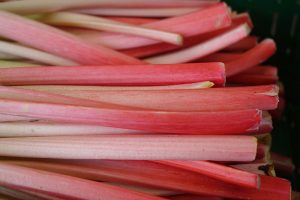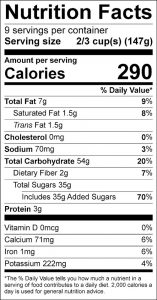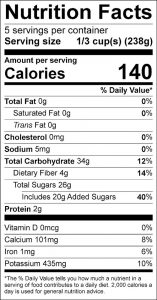Bulletin #4266, Vegetables and Fruits for Health: Rhubarb

Developed by Extension Nutrition Specialist Nellie Hedstrom, University of Maine Cooperative Extension.
For information about UMaine Extension programs and resources, visit extension.umaine.edu.
Find more of our publications and books at extension.umaine.edu/publications/.
You know that summer is on its way in Maine when the rhubarb stalks are large enough to gather. This tart stalk, colored deep red and topped with broad, bright-green leaves, grows in backyards and around farm buildings without much attention. Keeping plants well-fertilized is all that’s needed. The plants can usually be ignored until it is time to pick a few stalks for sauce, a springtime treat, or a tart rhubarb pie. The brightly colored stalks can be found in supermarkets as well as in farmer’s markets during the season. Some children even like to chew the stalks freshly picked.
Nutrition Information
Rhubarb, a spring tonic for vitamin C and calcium, is an easy and versatile fruit to use, although it provides only a moderate source of fiber. One of the drawbacks is that because it is so tart, most recipes call for more sugar than most other desserts. As with other fruits, 1/2 cup cooked rhubarb is considered a serving. A serving without sugar is only 29 calories, but with sugar it is 139 calories. By combining the stalks with sweeter fruits, like strawberries, the sugar content can be lowered quite a bit.
Selection
Field-grown rhubarb is on the market shelves between April and June in most areas. Choose stalks that are well-colored, good-sized, straight, and firm. Sometimes, rhubarb is sold with the leaves attached; they should be fresh-looking and crisp. Avoid stalks that are wilted or flabby.
Storage
After cutting off the leaves, wash the stalks. Store them in a plastic bag in the crisper of the refrigerator. Use within one week. (Caution: Rhubarb leaves contain a toxic substance that makes them poisonous. Be sure the leaves are removed before using the stalks. Discard them without cooking or eating.)
Preparation
Before cooking, trim stalks at the top and bottom. Trim any bruised spots. Wash stalks. For sauces or stewing, cut the rhubarb into one- to two-inch chunks. If the stalks are fresh, the fibers can be cut easily and will soften when cooked.
The two popular cooking methods include baking and stewing for sauces. Rhubarb sauce is made by placing the cut pieces in a saucepan. A stainless steel or Teflon™-coated pan is preferred. Rhubarb is highly acid and may react to some metals such as aluminum. Add 2/3 cup of water to the pan, and bring to a boil. Add 4 cups of cut rhubarb (six to eight stalks). Reduce heat, and simmer over low heat for about five minutes, or until rhubarb is tender. Add sugar to taste; between 3/4 and one cup is sufficiently sweet for most people. If you like less sugar, start with a smaller amount and taste-test the fruit before serving. Cold rhubarb sauce will not taste as sweet.
Rhubarb Crunch
Serves 9
1 cup flour
3/4 cup oatmeal, quick-cooking
3/4 cup brown sugar, packed
1/3 cup margarine, melted
1 teaspoon cinnamon
4 cups rhubarb, cut into 1-inch slices
3/4 cup sugar
2 tablespoons cornstarch
1 cup water
1 teaspoon vanilla
Mix flour, oatmeal, brown sugar, margarine and cinnamon until crumbly. Press half of mixture in the bottom of a 9X9-inch pan. Layer the rhubarb on top. In a separate pan, combine sugar and cornstarch until smooth, then add the water and vanilla. Cook over medium heat until the mixture is thick and clear. Pour the sauce over rhubarb. Top with remaining crumbs and bake at 350°F for 50 to 60 minutes. Serve warm.
Rhubarb-Strawberry Topping
Serves 5 (1/3-cup servings)
4 cups rhubarb, cut in one inch chunks
1/2 cup sugar
1/3 cup water
2 1/2 teaspoons cornstarch
1 tablespoon water
3 cups strawberries, sliced
1 teaspoon vanilla flavoring
Combine first three ingredients in a medium saucepan, and bring to a boil. Reduce heat and simmer uncovered for 5 minutes or until the rhubarb is tender. Combine 1 tablespoon water and cornstarch; stir well, and add to rhubarb mixture. Bring to a boil, stir constantly, and cook 1 minute or until thickened. Remove from heat; stir in strawberries and vanilla. Serve warm or chill over custard, low-fat ice cream, or angel food cake.
Some content adapted with permission from University of Massachusetts Cooperative Extension.
Information in this publication is provided purely for educational purposes. No responsibility is assumed for any problems associated with the use of products or services mentioned. No endorsement of products or companies is intended, nor is criticism of unnamed products or companies implied.
© 1997, 2007
Call 800.287.0274 (in Maine), or 207.581.3188, for information on publications and program offerings from University of Maine Cooperative Extension, or visit extension.umaine.edu.
In complying with the letter and spirit of applicable laws and pursuing its own goals of diversity, the University of Maine System does not discriminate on the grounds of race, color, religion, sex, sexual orientation, transgender status, gender, gender identity or expression, ethnicity, national origin, citizenship status, familial status, ancestry, age, disability physical or mental, genetic information, or veterans or military status in employment, education, and all other programs and activities. The University provides reasonable accommodations to qualified individuals with disabilities upon request. The following person has been designated to handle inquiries regarding non-discrimination policies: Director of Institutional Equity and Title IX Services, 5713 Chadbourne Hall, Room 412, University of Maine, Orono, ME 04469-5713, 207.581.1226, TTY 711 (Maine Relay System).



